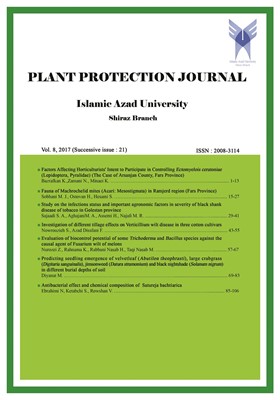Study on the infections status and important agronomic factors in severity of black shank disease of tobacco in Golestan province
Subject Areas : Plant Protectionseyyed afshin sajjadi 1 , Mohammad Ali Aghajani 2 , Hoda Assemi 3 , Mohammad Reza Najafi 4
1 - Plant Protection Department of Tirtash Research and Education Center (Behshahr)/Iran
2 - Agricultural and Natural Resources Research Center of Golestan, Gorgan
3 - Plant Protection Department of Tirtash Research and Education Center
4 - Plant Protection Department of Tirtash Research and Education Center
Keywords:
Abstract :
Phytophthora nicotianae Breda de Haan (=P. parasitica Dasture) is the causal agent of black shank disease and one of the most important pathogen in tobacco fields. In order to study the infection status of this disease in tobacco fields of Golestan province, 45 tobacco fields in five different regions of Gorgaan (Taghartappeh, Jafarabad, Ghorogh, Nodehmalek and Valeshabad) and four different regions of Aliabad (Pichakmahaleh, Baraftan, Fazelabad and Elazman) selected in 2014. The amount of disease was recorded during the infection period from the beginning of symptoms appearance, weekly. Stat Graphics Centurion XVI and Harward Graphics softwares were used to statistical analysis and draw charts of the development of epidemiological models, respectively. The factors influencing the epidemiology of disease were determined using two statistical methods of analysis of discriminant analysis and logistic regression. Based on the highest disease incidence there were no significant differences between regions, but there were significant differences (P<0.001) between fields. One field with disease incidence 43.4% in Valeshabad had the highest disease incidence. Jafarabad with 23.64% disease incidence had the highest infection and Nodehmalek with 16.4% disease incidence had the lowest infection. The results of this study show that disease of tobacco black shank in two regions of Gorgan and Aliabad in Golestan province with different rate of expansion. Study of temporal analysis of the epidemic using five different growth models (Exponential, Monomolecular, Logistic, Gompertz and Log-Logistic) showed that the Gompertz was the best fit model for describing this disease epidemic in the Golestan province condition. Weather conditions were similar in the different regions in 2015 year. The amount of fungi and nematode of inoculum in soil, Number of spraying in field and seedbed, duration of irrigation, rotation and soil texture were the most important variables in the incidence of disease in the Golestan province in the 2015 crop year.
_||_


